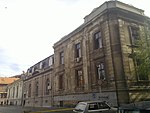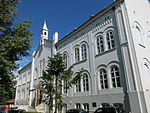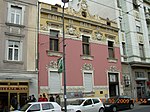Serbia and Montenegro (Serbian: Cрбија и Црна Гора, romanized: Srbija i Crna Gora) was a country in Southeast Europe located in the Balkans that existed from 1992 to 2006, following the breakup of the Socialist Federal Republic of Yugoslavia (SFR Yugoslavia) which bordered Hungary to the north, Romania to the northeast, Bulgaria to the southeast, Macedonia to the south, Croatia and Bosnia and Herzegovina to the west, and Albania to the southwest. The state was founded on 27 April 1992 as the Federal Republic of Yugoslavia, known as FR Yugoslavia or simply Yugoslavia which comprised the Republic of Serbia and the Republic of Montenegro. In February 2003, FR Yugoslavia was transformed from a federal republic to a political union until Montenegro seceded from the union in June 2006, leading to the full independence of both Serbia and Montenegro.
Its aspirations to be the sole legal successor state to SFR Yugoslavia were not recognized by the United Nations, following the passing of United Nations Security Council Resolution 777, which affirmed that the Socialist Federal Republic of Yugoslavia had ceased to exist, and the Federal Republic of Yugoslavia was a new state. All former republics were entitled to state succession while none of them continued SFR Yugoslavia's international legal personality. However, the government of Slobodan Milošević opposed any such claims, and as such, FR Yugoslavia was not allowed to join the United Nations.
Throughout its existence, FR Yugoslavia had a tense relationship with the international community, as economic sanctions were issued against the state during the course of the Yugoslav Wars and Kosovo War. This also resulted in hyperinflation between 1992 and 1994. FR Yugoslavia's involvement in the Yugoslav Wars ended with the Dayton Agreement, which recognized the independence of the Republics of Croatia, Slovenia, and Bosnia and Herzegovina, as well as establishing diplomatic relationships between the states, and a guaranteed role of the Serbian population within Bosnian politics. Later on, growing separatism within the Autonomous Province of Kosovo and Metohija, a region of Serbia heavily populated by ethnic Albanians, resulted in an insurrection by the Kosovo Liberation Army, an Albanian separatist group. The outbreak of the Kosovo War reintroduced Western sanctions, as well as eventual Western involvement in the conflict. The conflict ended with the adoption of United Nations Security Council Resolution 1244, which guaranteed economic and political separation of Kosovo from FR Yugoslavia, to be placed under UN Administration. Kosovo declared independence in 2008.
Economic hardship and war resulted in growing discontent with the government of Slobodan Milošević and his allies, who ran both Serbia and Montenegro as an effective dictatorship. This would eventually cumulate in the Bulldozer revolution, which saw his government overthrown, and replaced by one led by the Democratic Opposition of Serbia and Vojislav Koštunica, which also joined the UN.The Federal Republic of Yugoslavia ended in 2003 after the Federal Assembly of Yugoslavia voted to enact the Constitutional Charter of Serbia and Montenegro, which established the State Union of Serbia and Montenegro. As such, the name Yugoslavia was consigned to history. A growing independence movement in Montenegro, led by Milo Đukanović meant that the Constitution of Serbia and Montenegro included a clause allowing for a referendum on the question of Montenegrin independence, after a period of three years had passed. In 2006, the referendum was called, and passed, by a narrow margin. This led to the dissolution of the State Union of Serbia and Montenegro, and the establishment of the independent republics of Serbia and Montenegro, turning Serbia into a landlocked country. This can be considered the last act which finalized the dissolution of Yugoslavia.











